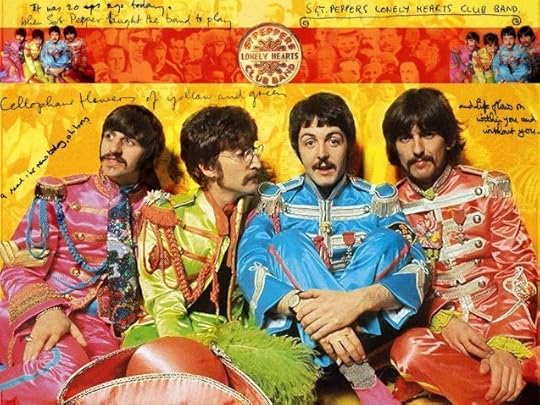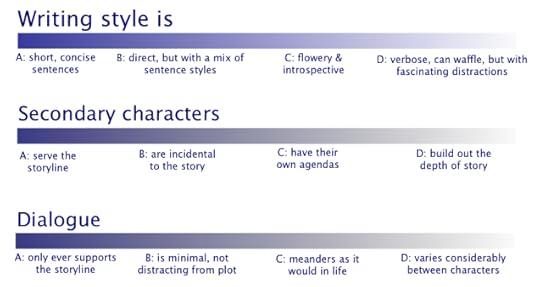Peter Cawdron's Blog, page 14
April 4, 2014
Dear parents, you are being lied to.
Lies feed on uncertainty, even where there’s none to be found scientifically.
 Originally posted on Violent metaphors:
Originally posted on Violent metaphors:

In light of recent outbreaks of measles and other vaccine preventable illnesses, and the refusal of anti-vaccination advocates to acknowledge the problem, I thought it was past time for this post.
Dear parents,
You are being lied to. The people who claim to be acting in the best interests of your children are putting their health and even lives at risk.
View original 1,134 more words


March 12, 2014
Book Giveaway
Hi all, I’m giving away autographed copies of Feedback, Little Green Men and Xenophobia on Goodreads. You can find the links below.
Here’s a video of me unboxing the latest shipment of books from Createspace showing the new covers designed by Jason Gurely.
FEEDBACK
Goodreads Book Giveaway

Feedback
by Peter Cawdron
Giveaway ends April 20, 2014.
See the giveaway details
at Goodreads.
LITTLE GREEN MEN
Goodreads Book Giveaway

Little Green Men
by Peter Cawdron
Giveaway ends April 20, 2014.
See the giveaway details
at Goodreads.
XENOPHOBIA
Goodreads Book Giveaway

Xenophobia
by Peter Cawdron
Giveaway ends April 20, 2014.
See the giveaway details
at Goodreads.


March 6, 2014
Cosmos Revisited
This weekend, Neil deGrasse Tyson is appearing in a reboot of Carl Sagan’s Cosmos, which will undoubtedly awaken a new generation to the wonders of our universe. In light of this, here are some of my favorite quotes from Carl Sagan.
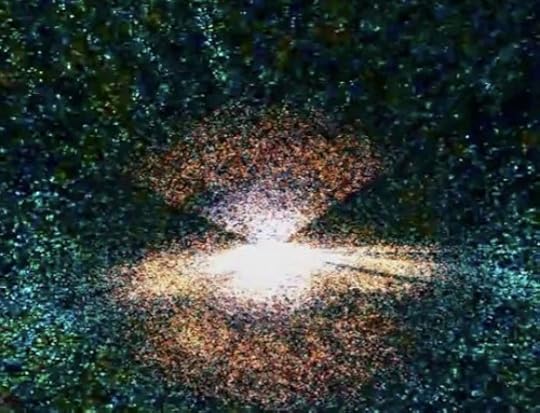
Picture credit: Sloan Digital Sky Survey. The specks of light you can see are not stars, not even galaxies, they’re quasars, phenomenally energetic black holes at the center of large galaxies. They thin out toward the edges not because there’s less of them further away from us but because we are looking back billions of years to when they were less developed.
“The size and age of the Cosmos are beyond ordinary human understanding. Lost somewhere between immensity and eternity is our tiny planetary home. In a cosmic perspective, most human concerns seem insignificant, even petty. And yet our species is young and curious and brave and shows much promise. In the last few millennia we have made the most astonishing and unexpected discoveries about the Cosmos and our place within it, explorations that are exhilarating to consider. They remind us that humans have evolved to wonder, that understanding is a joy, that knowledge is prerequisite to survival. I believe our future depends on how well we know this Cosmos in which we float like a mote of dust in the morning sky.”

Picture credit: British Museum. The Rosetta Stone was used to unlock the meaning of hieroglyphics, allowing us to understand an ancient culture and people otherwise lost to the mists of time.
“One glance at (a book) and you hear the voice of another person – perhaps someone dead for thousands of years. Across the millenia, the author is speaking, clearly and silently, inside your head, directly to you. Writing is perhaps the greatest of human inventions, binding together people, citizens of distant epochs, who never knew one another. Books break the shackles of time.”

Picture credit: NASA. New stars (out of sight at the top left) blow away dark molecular clouds within a stellar nursery. The dark blobs on the lower right are resisting these stellar winds, caught in a race to undergo gravitational collapse into another infant star before being dissolved. Every person that has ever lived, every blade of grass that has ever sprung forth, everything you see on Earth was once part of a molecular cloud like this.
“We inhabit a universe where atoms are made in the centers of stars; where each second a thousand suns are born; where life is sparked by sunlight and lightning in the airs and waters of youthful planets; where the raw material for biological evolution is sometimes made by the explosion of a star halfway across the Milky Way; where a thing as beautiful as a galaxy is formed a hundred billion times – a Cosmos of quasars and quarks, snowflakes and fireflies, where there may be black holes and other universe and extraterrestrial civilizations whose radio messages are at this moment reaching the Earth. How pallid by comparison are the pretensions of superstition and pseudoscience; how important it is for us to pursue and understand science, that characteristically human endeavor.”

Picture credit: Connect. Life brings meaning to the universe, turning stardust into something wonderful beyond compare.
“We are the local embodiment of a Cosmos grown to self-awareness. We have begun to contemplate our origins: starstuff pondering the stars; organized assemblages of ten billion billion billion atoms considering the evolution of atoms; tracing the long journey by which, here at least, consciousness arose. Our loyalties are to the species and the planet. We speak for Earth. Our obligation to survive is owed not just to ourselves but also to that Cosmos, ancient and vast, from which we spring.”

Picture credit: Nus The mechanics of how you think are far more important than anything you know.
“Knowing a great deal is not the same as being smart; intelligence is not information alone but also judgement, the manner in which information is coordinated and used.”

Picture credit: ALMA. Atacama Large Millimeter/submillimeter Array (ALMA) by night, under the Magellanic Clouds
“The total amount of energy from outside the solar system ever received by all the radio telescopes on the planet Earth is less than the energy of a single snowflake striking the ground.”
I’m looking forward to the new Cosmos series. With thinking like this…
I’m confident Neil deGrasse Tyson is going to continue Carl Sagan’s legacy


March 3, 2014
Interview with Ernie Lindsey
Recently, I had the opportunity to participate in an anthology of short stories called From the Indie Side and got to meet a bunch of authors I’d only ever seen from a distance. In this blog post, I’m interviewing one of these authors, Ernie Lindsey.
Ernie is a USA Today best selling author with over a dozen books to his name. His latest novella, How White People Die is available on Amazon.
What are you working on?
 I just finished up an insane writing marathon where I finished five novels in as many months, plus a couple of short stories. Reminds me of Forrest Gump where he’s out in the middle of the desert, stops running, and says, “I’m pretty tired… I think I’ll go home now.” That said, I tried to take a break, but that’s the burden of having too many stories in your head and motivation to get them all down before they disappear.
I just finished up an insane writing marathon where I finished five novels in as many months, plus a couple of short stories. Reminds me of Forrest Gump where he’s out in the middle of the desert, stops running, and says, “I’m pretty tired… I think I’ll go home now.” That said, I tried to take a break, but that’s the burden of having too many stories in your head and motivation to get them all down before they disappear.
So, at the moment, I’m working on a piece for Kindle Worlds, which is set in Marcus Sakey’s world of Brilliance. I loved the novel and the vision of society that he created, and so far, it’s been a lot of fun to dabble in it. I love the fact that folks like Hugh Howey, Marcus Sakey, and all the incredible storytellers who allow us to play around in their creations. The thing is, inside their imaginations where these worlds are built, they’re only telling ONE story of many, and there’s so much room to explore. I’m excited about getting this one out there.
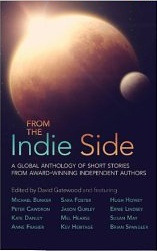 How does your work differ from others in its genre?
How does your work differ from others in its genre?
Interesting. (Ponders for entirely too long…) I’m not entirely sure that it does, and I’m okay with that. …I think…
Genre is genre, and we all have our own unique voices, and you do your best to tell the best story possible. I sound like a NASCAR driver trying to give the standard platitudes. I’d like to thank the Ford Chevy Diet Coke Nabisco racing team for their efforts. We put a great car on the track today…
You know, if I absolutely had to pick something that makes my work stand out from the pack, I’d say it’s the fact that for me, there’s minimal buildup to the action. I drop a reader right into the middle of the car chases, the gun fights, the kidnappings, and leave them little room to catch a breath for the next three hundred pages. I try to limit the peaks and valleys of intensity, and to continue the NASCAR theme the pedal is always to the metal.
Why do you write what you do?
As fledgling writers, we’re told to write what we know, but if I were to do that, I’d be inundating the literary world with stories about a former technical writer creating instructional guides that nobody reads. I write the types of stories that I do because it’s what I’d want to read if I randomly picked up one of my books at the library or a bookstore.
The weird thing is, I have hundreds of books on my Kindle, but now and then, I’ll catch myself reading one of my own novels (always looking for things to tweak) and instead of working on the story, I’ll find myself getting sucked into the plot. Such a strange feeling.
How does your writing process work?
 Man, it’s a mish-mash of regimented discipline and haphazard fits and starts. When I’m definitely into a story I’m telling, I’ll set timers and write for twenty-five minutes and then take a five-minute break. I’ll rinse and repeat that for three or four hours at a time until my mind goes to mush, then I’ll take a longer break and start all over again. Typically, using this method, I can crank out three to five thousand words in an uninterrupted day. When it’s haphazard, I’ll be all over the house putting laundry away, cleaning up after our toddler, washing bottles and dishes, whatever, in an effort to keep the task-oriented side of my brain occupied while the creative side works on the plot. It’s not unusual to find the bed half made because an answer presented itself and I had to run back to the computer.
Man, it’s a mish-mash of regimented discipline and haphazard fits and starts. When I’m definitely into a story I’m telling, I’ll set timers and write for twenty-five minutes and then take a five-minute break. I’ll rinse and repeat that for three or four hours at a time until my mind goes to mush, then I’ll take a longer break and start all over again. Typically, using this method, I can crank out three to five thousand words in an uninterrupted day. When it’s haphazard, I’ll be all over the house putting laundry away, cleaning up after our toddler, washing bottles and dishes, whatever, in an effort to keep the task-oriented side of my brain occupied while the creative side works on the plot. It’s not unusual to find the bed half made because an answer presented itself and I had to run back to the computer.
Other than that, I’m a total pantser. I can’t plot out my stories with outlines or mindmaps because I find it too limiting. To me, it feels like I’m square-peg-round-holing it, trying to make the characters do what they need to do in order to fit where the story is going. I’ve tried to plot like that and it ruins me every time a character starts misbehaving and derails the story by ten thousand words. It’s too hard for me to go back and fix what feels like the natural progression of the story.
So, instead, I write the story like I’m reading it. I solve the mystery with the characters—sometimes with them, sometimes a chapter or two sooner, but I figure that in the end, if a story can surprise the one guy who *should* know where everything is going, it’ll be doubly exciting for the reader.
Alright, that’s it!
You can find Ernie at www.ernielindsey.com
Happy reading!
March 2, 2014
Beginner’s Guide to Relativity
Einstein was a genius, there’s no doubt about that. But don’t let that deter you from wanting to understand relativity, as although it seems counterintuitive, it’s not too difficult to grasp. Surprisingly, at a basic level, it requires only high school math.
The first thing to understand about Einstein’s theory of relativity is that it is a description of reality. That is to say, relativity is not some vague, esoteric notion or ethereal concept like transubstantiation. Relativity is an explanation for what we observe of reality.
Let’s explore this a little…
Speed is a simple concept. Look at the speedometer on a car and the measurement is mph or kph, miles per hour or kilometers per hour, depending on where you live in the world. And that’s all velocity is, distance over time: v = d/t

Picture credit: Superstock
Speed is relative, or at least we intuitively think it is.
If you’re walking down the aisle of a plane travelling at 600 mph, how fast are you going? A casual walk is about 2 mph, so if you’re walking toward the front of the plane, your speed relative to the ground is 602 mph. Walk toward the back of the plane and your speed is 598 mph. Seems simple enough, doesn’t it.
One of the startling discoveries of the late 1800s was that the speed of light was the same in every direction regardless of motion.Scientists measured the speed of light at 670,616,629 mph (186,282 miles per second). For simplicity’s sake, let’s just call it 670 million miles per hour.
For a couple of decades, scientists scratched their heads at this finding, repeating their experiments and confirming something that seemed entirely counterintuitive. The speed of light never varied, even though “common sense” said it should.
Let’s go back to our 747 to understand this better.
When you walk down the aisle of a 747, your personal speed (relative to the plane) is 2 mph in both directions, but relative to the ground, you’re travelling at 598 mph when walking toward the tail and 602 mph when walking to the cockpit.

Picture credit: Zazzle
Now, if you stand in the aisle and shine a light at the cockpit and then at the tail, you would measure the speed of light in both directions as 670 million miles per hour. No surprises here. Just as you walked in either direction at 2 mph, light travels in either direction at 670 616 629 mph.
The “problem” arises when we measure your speed from the ground. When you walk toward the tail, your speed relative to the ground is no longer the same as the airplane. The plane is traveling at 600 mph but you’re travelling at 598 mph.
The “problem” is the speed of light is not relative. The speed of the light you shined toward the back of the plane is still exactly 670 616 629 mph.
Walk toward the front of the plane, and your speed relative to the ground is 602 mph because you are travelling a distance of 602 miles in an hour, but the light you shine is still travelling at exactly 670 616 629 mph. Why? Why isn’t the speed of light 670 617 229 mph (670 616 629 + 600)? It works that way for you walking around within the plane, why doesn’t it work that way for light shone within the plane?
Einstein’s brilliance came in accepting the results of these kind of experiments as reality, and then developing a theory that incorporated them accurately. Rather than trying to shoehorn what appeared to be “common sense,” he realized the results of this experiment revealed something profound about reality: time is fluid.
Remember our formula for speed? Miles per hour, or v = d/t. It’s a simple equation. There’s only three elements. Velocity equals distance travelled over time taken. If the velocity of light remains the same while the distance has changed due to the motion of the plane, the ONLY explanation is that time has also changed to compensate.
And you can calculate by how much time changes with a spreadsheet.
(1 – plane speed2/ speed of light2)0.5
If you want to play along at home using a spreadsheet, this would be…
=(1 – ((A1^2)/(A2^2)))^0.5
Where A1 = the plane’s speed in mph and A2 = the speed of light in mph.
1 second on the ground equals 0.9999999999996 seconds in the air
As you can see, it’s a minuscule effect, which is why relativity went unnoticed for so long.
The Voyager space probe is travelling 35,000 miles per hour so over the course of a year, time is slowed by a second.
A popular notion in science fiction is the idea of time dilation for space travellers, but even if you were travelling at half a million miles an hour, that would only equate to about three and a half minutes difference each year. You have to go very fast for a long period of time before time dilation would ensure you were younger than your grandchildren on Earth, but thanks to Einstein, we know that this isn’t fiction.
Time is elastic. Any time anyone is travelling at any speed relative to you, time is passing slower for them, be that someone driving by in a car or whizzing past in some absurdly fast spaceship. It’s just a question of by how much. Time dilates. That’s what it does.
Even the Beatles, tripping on acid, couldn’t have come up with something as outlandish as relativity. Once again, truth is stranger than fiction could ever be!
Bonus: Einstein also correctly deduced that the effect of gravity is the same as constant acceleration. Here’s a wonderful photo of an airplane in a roll. The constant change in angular momentum is mimicking constant acceleration, which in turn is mimicking gravity, and the pilot can pour a glass of water upside down. How awesome is that?

Picture credit: Reddit


February 9, 2014
Feedback: a novel by Peter Cawdron
I’m excited to announce the release of my latest novel, FEEDBACK.

Cover design: Jason Gurley
Synopsis
Twenty years ago, a UFO crashed into the Yellow Sea off the Korean Peninsula. The only survivor was a young English-speaking child, captured by the North Koreans. Two decades later, a physics student watches his girlfriend disappear before his eyes, abducted from the streets of New York by what appears to be the same UFO.
Feedback will carry you from the desolate, windswept coastline of North Korea to the bustling streets of New York and on into the depths of space as you journey to the outer edge of our solar system looking for answers.
You can find FEEDBACK in the Amazon Kindle store.
My thoughts on writing
Writing is an art.
Hugh Howey recently made the point that writing a novel is a bit like running a marathon. Anyone can do it, well, I couldn’t with my dodgy knee, but most people could run a marathon if they put their mind to it and put in the hard work necessary to train beforehand. But you can’t just throw on a pair of sneakers and turn up at the starting line. As my editor, Ellen Campbell, will attest, getting FEEDBACK produced has taken a marathon effort.
One of the criticisms often leveled at indie writing is that there’s a lack of professionalism, but that stigma is rapidly becoming outdated. Easily 2/3 of the effort required to produce a novel like FEEDBACK comes from editing, re-editing, revising, reviewing and polishing the story so it shines like a gemstone. Find an indie author prepared to do that, and you’ll always get a top-notch story.
What advice would I give to aspiring authors?
Aspire no more — the only way to grow as a writer is to write.
Write short stories & fan fiction — seriously, it’s fun, rewarding and a great way to grow. Writing a novel is a herculean task. You’ll probably underestimate the effort and commitment required for a full-length novel, so start small and build from there. I love Kindle Worlds. Get something out there for people to read.
Kill your darlings — this is a bit of a cliche, but I mean it in terms of your writing. I culled 25,000 words out of Xenophobia based on beta-reader feedback. That’s a quarter of the book gone with a single keystroke, and a publication delay of almost two months, but the story was better for the revision. Be ruthless. If you don’t, you’ll never grow as a writer.
Don’t look at reviews or sales stats or author rankings — seriously, don’t do it. You don’t need affirmation from others. Write because you love to write. I try to limit myself to peering into these dark webs once a month. I try. Reviews, sales & rankings are a fickle yardstick with which to measure yourself. Avoid them like the plague.
Don’t take rejection personally — all writers love five star reviews, myself included, but look closely at any 1, 2, 3 or 4 star reviews you get. Look for what you can learn. If I get a one star review, I’ll look at what that reviewer rated five stars and download at least a sample of that book, as I want to learn how I can do better. Sure, there’s nothing to learn from trolls, but most low star ratings are genuine. For some reason, the story missed the mark. Learn from that.
Surround yourself with people who make you a better writer — I don’t have many beta-readers, but I’m thankful for those I have and their input is invaluable.
Respect the reader — readers are placing a portion of their lives in your hands while they read. They’re giving up something far more precious than a few bucks, they’re giving up their time. There’s always a risk of mistakes creeping through, but do everything you can to polish your story to perfection for their sakes.
Learn from other indie authors — check out Favorite posts for writers on Hugh Howey’s home page, tap into indie groups online, talk with other authors about what works and what doesn’t. Mathew Mather and I recently swapped notes on how we approach character studies when planning a novel. We both took advantage of the opportunity to learn from each other.
Have fun
Thank you for supporting independent science fiction. If you do grab a copy of FEEDBACK please leave a review online as your thoughts and insights are invaluable in helping others determine whether this is a book they’d enjoy.

Cover design: Jason Gurley


January 30, 2014
Anthologies are like a box of chocolates
 Late last year, I was honored to be asked to participate in an anthology called From the Indie Side, featuring some of the best indie writers on the planet.
Late last year, I was honored to be asked to participate in an anthology called From the Indie Side, featuring some of the best indie writers on the planet.
I’ve thoroughly enjoyed getting to know these writers as we’ve corresponded on various aspects of our stories.
Indie writing is exciting. Traditional publishing is a long, slow road to trudge, with no guarantee of results. Indie publishing holds no promise of success, but it is astonishingly quick, and yet that speed needs to be tempered with patience to ensure quality.
This anthology has been edited by Hugh Howey‘s editor David Gatewood to ensure the quality of stories is top notch. The cover design is by Jason Gurley.
For me, indie publishing has offered an avenue for growth as a writer that I would not have had in a traditional publishing environment, so I’m proud to be an indie and excited to contribute to this anthology.
Anthologies are like a box of chocolates. You get to sample a wide variety of stories in a wonderfully condense format and discover new authors you can explore.
If you like quirky short stories on a variety of subjects, you’ll love From the Indie Side. It’s got something for everyone.
Here’s the synopsis of each story.
The Winter Lands (Jason Gurley)
Jonathan Froestt lives alone in a retirement home. His family is gone. His friends are all dead. For over sixty years, he has been writing a novel, the pages collecting in his apartment in stacks. Nobody has ever read it. Until today.
Going Gray (Brian Spangler)
When their community is engulfed by a deadly, caustic fog, sixteen-year-old Emily and her family decide to escape to the one building they can think of that might be able to withstand the fog’s corrosive force: the shopping mall. But a trip to the mall has never been so desperate, or so terrifying.
Queen Joanna (Kate Danley)
Thrust into a loveless marriage of state, Queen Joanna soon discovers her new palace is home to many dark secrets. And when a face in the mirror confronts her with a dire warning, she realizes her life is at risk. Has she awakened a curse—or been struck by madness? “Queen Joanna” presents a haunting twist on the legend of Bloody Mary.
Mouth Breathers (Hugh Howey)
Moving to a new town, starting off at a new school, meeting new kids… it’s never easy. And it only gets harder when the new town and the new school and the new kids are on a different planet. But sometimes, something happens that makes it worth all the trouble.
The Man With Two Legs (Ernie Lindsey)
Many winters ago, the man with two legs managed to escape the oppressive maiming rituals of Tritan’s government. Now he stands on a hillside overlooking the city, a bomb in his rucksack, determined to bring about two impossible results: his mother’s rescue and freedom for his people.
Cipher (Sara Foster)
When Beatrice leaves her family behind to visit her father, she never imagines she might not see them again. But then a bomb goes off close to home, and Beatrice must rely on a stranger’s help to find out what’s happened—and whether or not her husband and children have survived.
Made of Stars (Anne Frasier)
A genius vampire named Sinclair creates an alternate world where vampires can experience a traditional human life of love, marriage, and children. Sixteen-year-old Gabriel is Sinclair’s beta tester and volunteers to fall in love with a coffee-shop girl. But when the pain of love becomes overwhelming, Gabriel questions his decision. “It’s too real,” he tells Sinclair. “You made it too real.”
Gyre-Witchery (Kev Heritage)
All Tam wanted was to be loved. Was that so hard? Made outcast because of her green eyes—the sign of witchery—Tamina, a well-meaning simpleton, is shunned by a superstitious people who blame her for the ills that have overtaken their small island. It was not her fault that she put on weight while the others starved, or that wild animals slunk at her side, or that men and women both desired and despised her. But change was coming, brought upon the back of a terrifying squall…
The War Veteran (Susan May)
For seventy years, World War II veteran Jack Baker has endured vivid flashbacks to that horrific June day on Omaha Beach. But tonight, the flashback will be terrifyingly different. Tonight it becomes real. Tonight, Jack’s seventy-year-old secret will come back to claim him.
The Greater Good (Mel Hearse)
When Lanie wakes up in a hospital bed with no idea how she got there, she tries desperately to work out why she was on the old loop road that’s been all but abandoned by the locals. Thinking there must be an obvious answer, Lanie leaves no stone unturned in her quest for an explanation. But when all is revealed, she is left with only one question—and no good answers.
REDOUBT (Michael Bunker)
Phillip is a militia commander who has planned for a decade to defend the pacifist Vallenses of Central Texas with his army if ever the world tips over and goes to hell. He never thought he’d be on a skiing trip to New Mexico when the end comes.
The Man Who Remembered Today (Peter Cawdron)
Kareem wakes with a headache. A bloody bandage wrapped around his head tells him this isn’t just another day in the Big Apple. The problem is, he can’t remember what happened to him. He can’t recall anything from yesterday. The only memories he has are from events that are about to unfold today, and today is no ordinary day.
From the Indie Side is available on Amazon


January 16, 2014
Peace in Amber
In 2013, Amazon launched Kindle Worlds, which enabled a commercial avenue for what has been disdainfully called fan-fiction.
Critics attacked the idea.
Readers attacked the idea, saying “it’s a stupid move,” and “it will never last.”
Even such stalwarts of science fiction as io9 attacked the idea, saying, “Kurt Vonnegut? F*CK AND NO. The man is one of America’s literary icons. To allow fan fiction based on his work is a disgrace.“
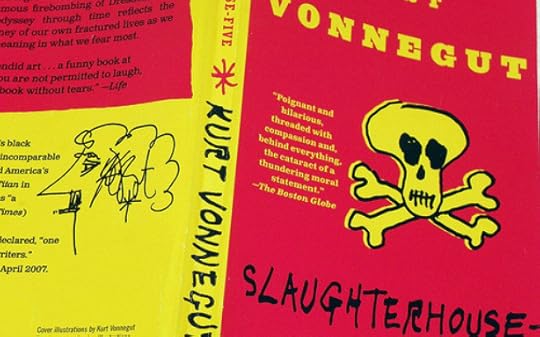
Picture credit: Inktank
Is there the possibility for fan-fiction to be a poor imitation of the original? Yes. But to assume that Kindle Worlds will “tarnish… America’s greatest authors,” is short-sighted. Rather than tarnishing Slaughterhouse Five, Hugh Howey has produced a story that is undoubtedly one of the greatest science fiction sequels ever penned.
There are a handful of stories that are iconic: Old Man and the Sea, Catcher in the Rye, To Kill a Mockingbird, 1984, Animal Farm, Slaughterhouse Five. It is with solemn respect that I suggest Peace in Amber joins those ranks as one of the few stories that captures the psyche of a nation.
In the same way in which Slaughterhouse Five captured the horrors of World War II and the bombing of Dresden, in centuries to come, people will read Peace in Amber to understand the impact of 9/11 on the heart and soul of America.
Peace in Amber is masterfully written, carefully echoing the style of Vonnegut while bringing a fresh, original perspective to the concept of the Tralfamadorians, a fictitious alien race that is unbound by time, seeing all of life in one sweeping vista.
Peace in Amber is written from two vantage points, that of Howey himself as a ship captain at dock below the World Trade Center on the morning of September 11, 2001, and Montana Wildhack, a character from Vonnegut’s original story. Montana was the mate selected by the Tralfamadorians for Billy Pilgrim, the protagonist of Slaughterhouse Five.

Picture credit: unknown
The prose is chilling. The alternating storyline blends with the chaos of the moment, and you are transported seamlessly from that fateful September morning across the universe and back again.
I’m on the wharf, looking up. There’s a plane howling across the clear blue sky, banking hard, coming in too fast. One building is burning, and another can’t get out of the way. A pattern is forming, but in my head I only have a silent scream to a pilot who is already dead. Pull up. Pull up. — Peace in Amber
Even the title, Peace in Amber, has been adapted from Slaughterhouse Five.
All time is all time. It does not change. It does not lend itself to warnings or explanations. It simply is. Take it moment by moment, and you will find that we are all, as I’ve said before, bugs in amber. — Slaughterhouse Five
Hugh Howey has written an American classic.
Without Kindle Worlds, Peace in Amber would have never been written and we would be the poorer for that loss.
September 11, 2001 stands as a pivotal moment in history in much the same way as December 7th, 1941 marked the end of America’s innocence. To capture the raw poignant emotion of this event in such a moving story is the essence of great literature.
For generations to come, this book will be a rallying point for those that seek to understand what we collectively felt on that day.
Rather than diminishing Vonnegut’s masterpiece, Hugh Howey has refreshed it for a new generation.
Kurt Vonnegut would love Peace in Amber.
Thank you, Hugh.
*Disclosure – I am a science fiction author who met Hugh Howey once. You’ll have to decide if that constitutes a bias. You can find Peace in Amber on Amazon Kindle Worlds


December 28, 2013
What is color?
Each year, the Alan Alda Center for Communicating Science issues the Flame Challenge, challenging scientists to communicate complex subjects to 11 year olds in 300 words or less. This year, the challenge was to explain color. Although I’m not a scientist and cannot compete, I couldn’t resist.
What is color?
Color is an important part of our world, but what is color?

Picture credit: Wikimedia Commons
Color is the result of our eyes catching light in different ways.

Picture credit: Sloan Digital Sky Survey
To someone that’s colorblind, these two images look the same. Color evolved so we could distinguish between shades of grey.

Picture credit: Sloan Digital Sky Survey (saved in black and white)
Other animals evolved to see slightly different portions of light.
Cats only have color receptors for green and blue, whereas humans have green, blue and red.
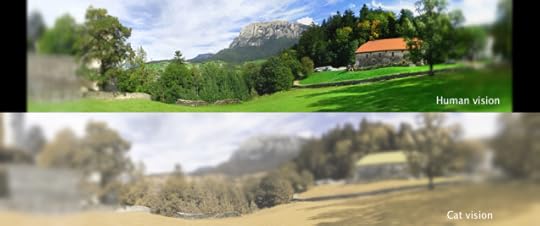
Picture credit: Nickolay Lamm
Cats may see less color, but they see better in the dark.

Picture credit: Nickolay Lamm
How can one flower be seen three different ways?
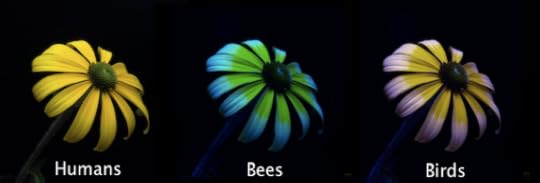
Picture credit: Nature.com
We don’t see all the light bouncing around us. We only see a thin strip of light. Shift that slightly so you have the vision of a bee, and you’ll see things that are invisible to our eyes.

Picture credit: West Mountain Apiary
If that isn’t weird enough, some animals see colors we can’t even begin to imagine.

Picture credit: Mantis Shrimp, Gizmo
The mantis shrimp sees twelve primary colors! Not only do shrimp see more colors than us, shrimp see over a wider range! What do these extra colors look like? We have no idea. Just as we couldn’t explain red to someone born colorblind, we can’t picture the colors a shrimp can see.

Picture credit:Pan Studios
What would an alien see if they came to Earth?
If an alien were to visit Earth they would probably have some form of sight. Sight is so useful it evolved independently on Earth over forty different times! An alien would have to be able to see the stars before traveling to them, but their sight would have evolved on an entirely different world, so they’re probably going to see differently, just like cats and bees.

Picture credit: , Predator, Twentieth Century Fox
What is color?
A convenient way our eyes perceive light. Our eyes interpret the black-and-white world around us, adding a touch of excitement to our sight.


An alternative to stars on reviews
Five star ratings are becoming increasingly meaningless on Amazon and GoodReads.
Every writer loves five star reviews, and I’m certainly no exception. There’s no doubt, five star reviews sell books, but how accurate a measurement are they of a quality to be found in a story?
The problem is… how can you compare WOOL by Hugh Howey with THE OLD MAN AND THE SEA by Ernest Hemingway?
WOOL is a wonderful story and has proven popular to a wide readership, gaining a phenomenal 7000+ reviews, but it is yet to have the longevity or literary impact of the Old Man.
On the surface, WOOL is a better story than THE OLD MAN AND THE SEA, but is that really the case? Or have we exposed how star ratings fail to adequately capture the essence of a book?
You see, the problem is we’re comparing apples and oranges. Both books are wonderful, but to make any kind of comparison between them is shortsighted. Ever tried orange pie?
The rating system on Amazon is structured like a footrace, ignoring the subtleties of literature.
I’d like to suggest we need an alternative means of rating books, one that perhaps runs in parallel with the star ratings, but one that categorizes content rather than judging enjoyment.
I’d recommend Amazon explores the possibility of developing a Briggs/Meyer style rating system where books are grouped by opposing characteristics, where no one characteristic is either good or bad. In this way, we can get honest representations of a book’s content. I’ll kick the discussion off with a few suggestions…
And then books that are AAA would be great for action/adventure, while DDD would be Proust, Hemingway, etc. In this way, people could match themselves with the writing styles they enjoy, and a five-star ABC book would not be confused with a five-star DDD, etc.
It may take a little more thought than clicking on a star, but if a reader really loves a story enough to leave a review, I think they’d like the opportunity express their estimation of the content accurately.
There is a world of difference between enjoying a book you read over the Christmas holidays and recognizing that a book transcends time and genre. Amazon’s current rating system doesn’t allow that distinction.
Come on, Amazon. Innovate!
PS: This doesn’t mean I don’t want reviews  Please, please, please leave honest reviews for everything you read regardless of the author. Your thoughts and opinions as a reader are invaluable to writers.
Please, please, please leave honest reviews for everything you read regardless of the author. Your thoughts and opinions as a reader are invaluable to writers.







